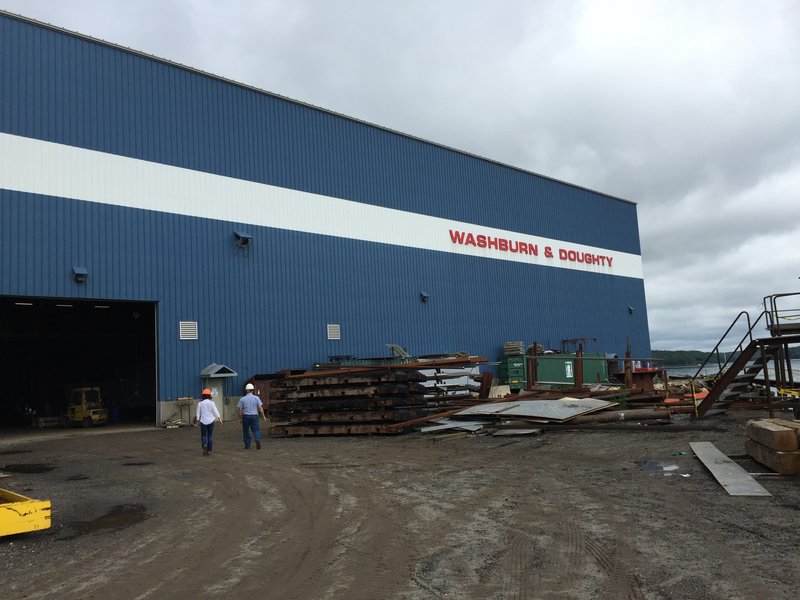Washburn & Doughty, East Boothbay, Maine, has been awarded a contract from Harbor Docking and Towing, Lake Charles, La., to design and build two 93'x38' hybrid Z-drive tugs. The hull is a proven design with 18 tugs in operation and four under construction. The vessel will be built as a harbor assist vessel to Subchapter M requirements and admeasure less than 200 gross tons U.S. regulatory tonnage.
Caterpillar Marine will provide a “stem-to-stern” content hybrid propulsion system, with support from Milton Cat and Louisiana Cat. The hybrid propulsion system includes twin Cat 3512E main engines, producing 2,550 hp at 1,800 rpm, each, two C18 generator sets, sparking 565-kW of electrical power, a C7.1 generator set, producing 200 kW of electrical power, shaft lines, MTA 628 azimuth drives with cu-ni-al bronze 2800-mm propellers and water-cooled thruster motors.

5,100-hp, 93' hybrid Z-drive tug for Louisiana. Washburn & Doughty rendering
The system also includes the switchgear, variable frequency drives (VFD), and a fully integrated control system. The main engines power the main thrusters via a shaft line. Between the main engine and the thruster there is a main clutch mounted in a bell housing attached to the engine. On the back end of the each thruster there is a thruster motor operated by a VFD controller .
“We are proud to have earned Harbor Docking and Towing’s business and we look forward to working with them on this innovative project,” Bruce Doughty, Washburn & Doughty's chairman said in a statement announcing the new deal. “Cat’s hybrid system is a great fit for our 93-foot tug.”
The hybrid propulsion system has the four main operational modes:
- Electric (standby/transit) — The main thrusters are run via the attached thruster motors in variable speed mode. Electric power is generated by a diesel electric power plant consisting of two Caterpillar C18’s , and one C7.1. Transit speed is variable up to 9 knots.
- Diesel — main engines drive main thrusters mechanically in variable speed mode with electric power coming from one of the generator sets. Bollard Pull is predicted at 65 metric tons (72 short tons).
- Hybrid — main engines drive main propellers together with thruster motors powered via the generator sets. Bollard pull is estimated to be 80 metric tons (88 short tons).
- FiFi — Firefighting pump is powered from the front of starboard main engine PTO. Maneuvering is done with main thrusters operating in electric mode powered by generators.
The off-ship firefighting system will meet FiFi 1 requirements relating to water output. It will utilize one clutched FFS model SFP 300x40 0CW-NCI pump driven by the starboard main engine. Two FFS 1200 remote controlled fire monitors shall be mounted on the aft end of the 01 deck. They will be controlled by the FFS control panel in the pilothouse. A deluge system will be supplied to cover the tug with water spray.
A Markey DEPCF-52, 75-hp electric hawser winch with level wind will be installed on the fore deck. Controls will be located in the pilothouse, with an emergency brake release/brake hold button located on the forward deckhouse bulkhead. A Palfinger PTM200 marine crane will be installed on the main deck built into the aft corner of the port stack. The crane has a telescoping boom with full extended length of 30'. Lifting capacity is 4,000 lb. at a 30' radius. A boom support will be fitted to the starboard stack for storage.
Bow fendering will consist of two upper rows of 24" cylindrical fender, a middle 16" soft loop fender, and a lower laminated fender. A 12" black rubber "D" fender will be fitted at the main deck on the sides and around the stern. Between the D fender and the middle bow fender there will be a double row of soft loop fender, with the aft end of the soft loop fender tapered to approximately the depth of the D fender.
There will be accommodations for six crew members in four staterooms. The joiner package will be completed by Senecal Construction, Brunswick, Maine.




